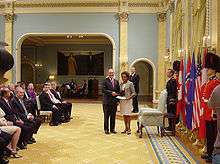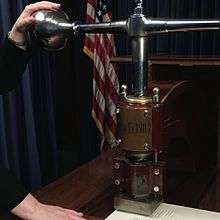Diplomatic correspondence
Diplomatic correspondence is correspondence between one state and another, usually – though not exclusively – of a formal character. It follows several widely observed customs and style in composition, substance, presentation, and delivery and can generally be categorized into letters and notes.
Letters
Letters are correspondence between heads of state, typically used for the appointment and recall of ambassadors; for the announcement of the death of a sovereign or an accession to the throne; or for expressions of congratulations or condolence.[1]

Letters between two monarchs will typically begin with the salutation "Sir My Brother" (or "Madame My Sister", in the case of a female monarch) and close with the valediction "Your Good Brother" (or sister, in the case of a female monarch), unless one monarch is of inferior rank to the other (if, for instance, the Grand Duke of Luxembourg were to correspond to the Queen of the United Kingdom) in which case the inferior monarch will use the salutation "sire" while the superior monarch may refer to the other as "cousin" instead of "brother".[1] A letter from a monarch to the head-of-state of a republic, vice versa, or of the head-of-state from one republic to another, may begin with the salutation "My Great and Good Friend" and close with the valediction "Your Good Friend"; beneath the signature line will be inscribed "To Our Great and Good Friend [Name and Title of Recipient]."[1]
Letters of credence
A letter of credence (lettres de créance) or credentials is the instrument by which a head of state exercises his or her power to appoint ("accredit") ambassadors and ministers to foreign countries.[2][3] The letter of credence is signed by the sending head of state and is addressed to the receiving head of state.[2] (In some countries, letters accrediting or recalling ambassadors or ministers are also countersigned by a minister of state).[1]
.jpg)
The particular elements of a letter of credence vary from country to country, but "the essence of any letter of credence is contained in the final phrase asking that credit may be given to all that the ambassador may say in the name of his sovereign or Government."[2] Usually "the appointment and reception of diplomatic representatives are matters of protocol and ceremony" but there are occasionally "legal implications in the context of questions as to the legitimacy of a particular head of State" because addressing letters of credence to, or accepting letters of credence from, a foreign head of state has implications relating to recognition of a particular government.[2] Letters of credence date to the thirteenth century.[4]
An envoy typically receives both a sealed letter of credence and an unsealed copy.[3] Once the envoy reaches his destination:
| “ | he sends the copy to the Foreign Office in order to make his arrival known. The sealed original, however, is handed personally by the envoy to the head of the State to whom he is accredited. Chargés d'affaires receive a letter of credence too, but as they are accredited from Foreign Office to Foreign Office, their letter of credence is signed, not by the head of their home State, but by its Foreign Office.[3] | ” |
Letters of recall
A letter of recall is formal correspondence from one head-of-state notifying a second head-of-state that he or she is recalling his state's ambassador.

Full powers
In cases where an envoy is entrusted with unusually extensive tasks that would not be covered by an ordinary permanent legation (such as the negotiation of a special treaty or convention, or representation at a diplomatic congress), an envoy may be given full powers (pleins pouvoirs) "in letters patent signed by the head of the State" designing "either limited or unlimited full powers, according to the requirements of the case."[3]
According to Satow's Diplomatic Practice, the bestowal of full powers traces its history to the Roman plena potestas; its purpose
was to be able to dispense, as far as possible, with the long delays needed in earlier times for referring problems back to higher authority. Their use at the present day is a formal recognition of the necessity of absolute confidence in the authority and standing of the negotiator.[1]
.jpg)
Notes
Note verbale
A note verbale is the most formal form of note and is so-named as it originally represented a formal record of information delivered orally. Notes verbale are written in the third person and printed on official letterhead; they are typically sealed with an embosser or, in some cases, a stamp. All notes verbale begin with a formal salutation, typically:[1]
| “ | The [name of sending state's] Embassy presents its compliments to the Ministry of Foreign Affairs and has the honor to invite their attention to the following matter. | ” |
Notes verbales will also close with a formal valediction, typically:[1]
| “ | The Embassy avails itself of this opportunity of assuring the Ministry of its highest consideration | ” |
Notes verbale composed by the British Foreign Office are written on blue paper.[1]

Collective note
A collective note is a letter delivered from multiple states to a single recipient state. It is always written in the third person.[5] The collective note has been a rarely used form of diplomatic communication due to the difficulty in obtaining agreements among multiple states to the exact wording of a letter.[6]
Identic note
An identic note is a letter delivered from a single state to multiple recipient states. Examples include the identic note sent by Thomas Jefferson regarding action against the Barbary Pirates and that from the United States to China and the Soviet Union in 1929. In it, the United States called on the other two powers to resolve their differences over the Eastern China Railway peacefully.[7]
Bouts de papier
A bout de papier (speaking note) may be presented by a visiting official when meeting with an official from another state at the conclusion of the meeting. Prepared in advance, it contains a short summary of the main points addressed by the visiting official during the meeting and, firstly, serves as a memory aid for the visiting official when speaking. It, secondly, removes ambiguity about the subject of the meeting occasioned by verbal miscues by the visiting official. Bouts de papier are always presented without credit or attribution so as to preserve the confidentiality of the meeting in case the document is later disclosed.[1]

Démarches and aides-mémoire
A démarche (non-paper) is considered less formal than the already informal bout de papier. Officially described as "a request or intercession with a foreign official" it is a written request that is presented without attribution from the composing state and is, therefore, delivered in-person.[8]
Similar to a démarche, an aide-mémoire is a proposed agreement or negotiating text circulated informally among multiple states for discussion without committing the originating delegation's country to the contents. It has no identified source, title, or attribution and no standing in the relationship involved.

Protocol
Language
The earliest forms of diplomatic correspondence were, out of necessity, written in Latin, Latin being a common language among states of a linguistically diverse Europe. By the early 1800s French had firmly supplanted Latin as the language of diplomacy; on one occasion, in 1817, the British attempted to correspond with the Austrian Imperial Court in English, prompting Klemens von Metternich to threaten retaliatory correspondence in German. In modern times, French has largely been replaced by English as a diplomatic lingua franca in correspondence between two states that do not share a common tongue.[9]
Rejection
States may sometimes reject diplomatic correspondence addressed to them by returning the original copy to the sending state. This is done as a rebuff of the contents of the correspondence and is typically reserved for cases where the receiving state feels the language used by the sending state is rude, or the subject matter represents an inappropriate intercession into the receiving state's internal affairs.[1]
See also
References
- 1 2 3 4 5 6 7 8 9 10 Roberts, Ivor (2009). Satow's Diplomatic Practice (6 ed.). Oxford University Press. pp. 45–66. ISBN 0199693552.
- 1 2 3 4 Joanne Foakes, The Position of Heads of State and Senior Officials in International Law (Oxford University Press, 2014).
- 1 2 3 4 Lassa Oppenheim, International Law: A Treatise (Vol. 1, 2005: ed. Ronald Roxburgh), § 371, p. 550.
- ↑ Pierre Chaplais, English Diplomatic Practice in the Middle Ages (Hambledon and London, 2003), p. 246.
- ↑ Acquah-Dadzie, Kofi (1999). World Dictionary of Foreign Expressions: A Resource for Readers and Writers. Bolchazy-Carducci Publishers. p. 273. ISBN 0865164231.
- ↑ Lloyd (2012). The Palgrave Macmillan Dictionary of Diplomacy. Springer. ISBN 1137017619.
- ↑ Murty, Bhagevatula (1989). The International Law of Diplomacy: The Diplomatic Instrument and World Public Order. Martinus Nijhoff Publishers. p. 184. ISBN 0792300831.
- ↑ Protocol for the Modern Diplomat (PDF). U.S. Department of State. 2013. p. 30.
- ↑ Hamilton, Keith (2011). The Practice of Diplomacy: Its Evolution, Theory, and Administration. Taylor & Francis. pp. 109–111. ISBN 0415497647.